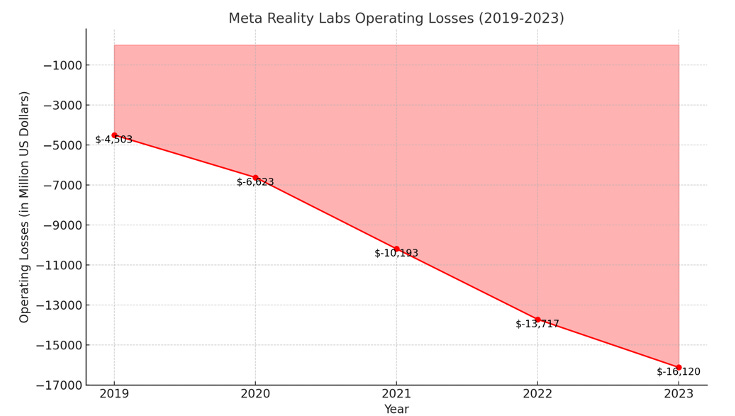Meta Orion vs. Apple Glasses vs. Samsung Smart Glasses (2024 Predictions)
Will Meta Orion be able to compete with Apple glasses & Samsung smart glasses? I have doubts.
All the tech nerds are hype about the Meta Orion AR smart glasses following the recent demos and announcements.
However, most don’t realize that these glasses are still a prototype that costs $10k to make, appear a bit bulky, and will likely have competition from the likes of Apple and Samsung.
If you’re betting on Meta doing well with hardware product sales – you might want to reconsider (as their historical performance 2019-2024 has been brutal).
Meta Reality Labs Products (2024)
Meta’s Reality Labs division sells the following products:
1. Meta Quest VR Headsets
Reality Labs' flagship products are the Meta Quest VR headsets:
Meta Quest 3: The latest mixed reality headset, released in 2023. It offers both VR and MR capabilities, allowing users to seamlessly blend virtual and physical worlds.
Meta Quest 3S: A more affordable VR headset priced at $299, announced in September 2024. It's designed for various uses including gaming, movie viewing, and VR fitness applications.
Meta Quest Pro: A high-end mixed reality headset introduced in October 2022, featuring eye tracking and Natural Facial Expressions.
These headsets are standalone devices that don't require a PC or external sensors to operate.
2. Ray-Ban Meta Smart Glasses
In partnership with EssilorLuxottica, Reality Labs produces smart glasses under the Ray-Ban brand.
Ray-Ban Meta Smart Glasses: Launched in October 2023, these glasses feature open-air audio for listening to music and taking calls, as well as the ability to capture photos and videos hands-free. They also integrate Meta AI, allowing users to interact with AI assistants using voice commands.
3. Software Platforms
Reality Labs also develops software platforms to support its hardware products:
Meta Quest Store: An online marketplace for VR applications and games (formerly known as Oculus Store).
Horizon Worlds: A social VR platform where users can create and explore virtual environments.
Reality Labs continues to innovate in the XR (extended reality) space, with plans for future products that will further integrate AR and AI technologies.
The division's goal is to create a range of devices that will form the fabric of future computing experiences, from current smart glasses to full AR glasses and advanced mixed reality headsets.
What should you know about the profitability of Reality Labs?
Reality Labs is far from profitable.
For the year 2023 the division operated at a loss of $16.12 billion.
Over the past 5 years (2019-2024) the Reality Labs division lost nearly $50 billion.
Not only is the division far from profitable, but the operating losses continue growing significantly each year.
Will Meta’s Orion AR glasses save the day for Reality Labs?
Maybe, but they’ll likely have serious competition regardless of whether they are first to release quality AR glasses.
This is why we should consider competition from major companies like Apple and Samsung – and compare what we know so far.
Smart Glasses Comparison: Meta vs. Apple vs. Samsung
Below are some rumored specs for each version of smart glasses from Meta, Apple, and Samsung – respectively (as of 2024).
1. Meta Orion AR Glasses
Design and Hardware:
Prototype Unveiled: Meta showcased the Orion AR glasses at Meta Connect 2024.
Materials: Uses silicon carbide for durability and lightness, with clear lenses.
Weight: 100 grams (3.5 ounces), aiming for comfort during long periods of wear.
Field of View: 70-degree FOV, offering an expansive AR experience.
Display Tech: Micro LED projectors and silicon carbide-etched waveguides for improved optics and clarity.
Display and Optics:
Resolution: 640x480 pixels, with an effective 11 pixels per degree (PPD).
Advanced Optics: May feature single-color microLEDs with up to 1920x1080 resolution.
Waveguide Technology: Uses a double-sided etching method for enhanced clarity in AR overlays.
Controls and Interaction:
Control System: Combines eye tracking, hand gestures, and a neural wristband for intuitive control.
AI Integration: Contextual AI built-in for environment awareness and interaction, improving user experience.
Battery and Performance:
Battery Life: Limited to 2-3 hours in full AR mode, typical for high-powered AR devices.
External Processor: Requires an external processing unit, a "puck," for handling apps and graphics.
Price and Availability:
Cost: Currently a prototype, costing around $10,000 to produce, but consumer versions are expected to be priced similarly to a high-end smartphone.
Release Date: No set consumer release date, though it is speculated to be available around late 2027.
2. Apple Smart Glasses (Rumored)
Design and Hardware:
Lightweight Design: Expected to resemble regular glasses, prioritizing comfort for daily wear.
Sensors: Likely to include LiDAR for depth sensing but may exclude cameras to prioritize privacy.
Display and Optics:
Display Tech: Rumored to use Sony OLED displays for crisp visuals, with information projected onto both lenses.
Controls and Interaction:
Gesture Controls: Likely to use gesture recognition for hands-free interaction.
Optic ID: A rumored biometric authentication system using eye scanning for secure logins.
Connectivity and Integration:
iPhone Dependent: The glasses are expected to rely on iPhones for data processing, minimizing onboard hardware.
Dedicated App Store: Could include its own App Store tailored for AR applications.
Features:
AR Integration: Capable of displaying AR maps, night vision, and interactive overlays. May automatically adjust lens displays for users with vision issues.
Price and Availability:
Cost: Estimated price range between $500 and $1,000, more affordable than Meta’s glasses.
Release Date: Still in development with no confirmed release date, though several years away from launch.
3. Samsung Smart Glasses (Rumored)
Design and Hardware:
Versatile Design: Could be AR glasses, VR headsets, or basic smart glasses, possibly with 3,000-dpi OLED displays and pancake lenses for clarity.
Controls and Interaction:
Eye and Hand Tracking: Expected to include eye tracking and hand tracking, with potential for advanced touch controls and even olfactory integration (smell detection).
Performance:
Processor: Likely to use a more powerful chipset than the Exynos 2200, suggesting high performance for mixed reality tasks.
Full-Color Passthrough: May include full-color passthrough like the Meta Quest 3, enhancing the mixed-reality experience.
Features:
Galaxy Ecosystem Integration: Will likely integrate tightly with Samsung’s existing product ecosystem, including Galaxy smartphones, tablets, and wearables.
Multiple Cameras: Expected to feature cameras for depth sensing and accurate tracking.
Price and Availability:
Cost: Estimated price range between $1,000 and $2,000.
Release Date: Potential debut as early as December 2024.
Which smart glasses are likely to perform best in terms of sales & profitability?
I’d guess Apple - for many reasons.
1. Apple’s Ecosystem and Consumer Trust
Ecosystem Integration
Apple’s smart glasses will likely integrate seamlessly with the existing Apple ecosystem (iPhones, iPads, Apple Watch, and Macs).
Given how Apple’s products work well together, this will encourage current Apple users to adopt the smart glasses as a natural extension of their devices.
The iPhone-dependence will ensure that a significant portion of Apple’s vast user base (over 1 billion active iPhone users) can easily adopt this new product without needing separate hardware investments.
Brand Loyalty
Apple has one of the most loyal customer bases in the world, which often translates into higher adoption rates for new products.
When Apple introduces a new category, its strong reputation for design, privacy, and ease of use ensures customer trust.
2. Likely Affordable Price Point
Price Accessibility
Compared to Meta’s high-end, enterprise-focused Orion AR glasses, which are expected to cost around $3,000+, and Samsung’s glasses, priced between $1,000-$2,000, Apple’s glasses are expected to be in the range of $500 to $1,000.
This might make them much more accessible to the average consumer, which could drive higher sales volume.
Mass Market Focus
Apple’s smart glasses will likely be targeted at everyday consumers rather than niche or enterprise markets.
By focusing on augmenting daily tasks such as notifications, maps, and hands-free interaction, Apple’s glasses will appeal to a wider audience, increasing adoption.
3. Proven Success in New Product Categories
Past Success
Apple has a history of succeeding in new product categories where others have struggled.
For instance, smartwatches existed before the Apple Watch, but Apple revolutionized the market and became the dominant player.
Similarly, with AirPods, Apple captured a large share of the wireless earbud market.
It’s likely Apple will leverage similar strategies to capture the AR glasses market by focusing on user experience, design, and integration.
Potential for Scale: Apple’s ability to scale production and market its products globally will allow it to dominate the smart glasses market once launched, assuming the product meets consumer expectations in terms of design and functionality.
4. Consumer-Oriented AR Applications
AR for Daily Use
Apple is expected to focus on practical augmented reality (AR) features that improve daily life, such as viewing notifications, navigation, or interacting with smart home devices.
This practical approach contrasts with Meta’s more immersive and enterprise-oriented AR focus, which may have a narrower target audience.
App Store Integration
If Apple creates a dedicated AR App Store for its glasses, developers will be incentivized to create apps that enhance the user experience, much like they did for the iPhone and Apple Watch.
This could further drive adoption and customer engagement, contributing to profitability.
Drew’s thoughts:
Apple's smart glasses are likely to dominate the market due to their seamless integration with the Apple ecosystem, affordable price point, and focus on practical AR applications for everyday users.
Meta’s Orion AR glasses are technologically advanced but with a high price and enterprise focus, making them less accessible to the average consumer.
Samsung's smart glasses could bridge the gap between AR and VR, but their market impact remains uncertain, with competition from both Apple and Meta expected to be strong.
Does Orion change my long-term investment thesis for Meta?
No. I actually think Meta will likely be a very good long-term investment.
Why? Reasons other than Orion AR glasses and the Reality Labs division.
Reality Labs may eventually turn profitable, but I’m highly skeptical of Meta’s future in hardware relative to its family-of-apps segment.
Meta’s strengths are: AI acceleration (open-source Llama models), business products, data centers, datasets (from FB, Whatsapp, IG, Messenger, Threads, etc.), and advertising optimization with AI.
In other words, fairly bullish Meta long-term but for reasons other than the Orion AR glasses… if they become a hit, its significant upside potential - but they’ll likely have strong competition from Apple and Samsung.





